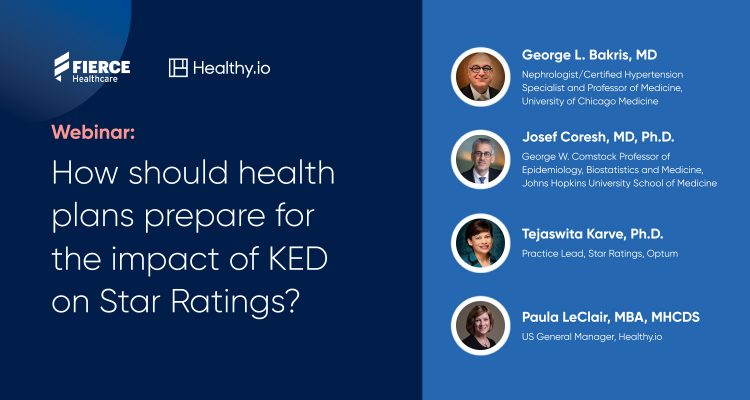A few years ago, the National Kidney Foundation and the National Committee for Quality Assurance developed a measure for kidney health called the Kidney Health Evaluation for Patients with Diabetes (KED). Designed to help divert patients away from dialysis through early detection of kidney disease, KED measures the percentage of adults with diabetes that have been assessed using estimated glomerular filtration rate (eGFR) and urine albumin creatinine ratio (ACR) tests in a 12-month period.
The Centers for Medicare and Medicaid Services have now announced the inclusion of KED as a measure that will directly impact a health plan’s Star rating. However, with less than 50% of the impacted population currently receiving the required annual ACR testing, health plans must rethink how they engage their members to ensure new testing requirements are met.
Alongside Fierce Healthcare, we recently hosted a webinar with several experts to discuss the current state of kidney care and the new KED measure. The event was moderated by Daniel Kraft, founder of NextMed Health, and featured panelists:
- George L. Bakris, MD, Nephrologist/Certified Hypertension Specialist and Professor of Medicine, University of Chicago Medicine
- Josef Coresh, MD, Ph.D., George W. Comstock Professor of Epidemiology, Biostatistics and Medicine, Johns Hopkins University School of Medicine
- Tejaswita Karve, Ph.D., Practice Lead, Star Ratings, Optum
Here are a few highlights from the discussion:
Importance of monitoring albuminuria
ACR testing is used to detect elevated levels of albuminuria, which is an early indicator and risk predictor of kidney disease, heart disease, and other health complications. However, you can be entirely asymptomatic and have albuminuria present in your urine, providing an early warning that something is wrong.
Kidney disease is a silent killer. You don't have any symptoms until the party's over. So it's very important to understand, if you're spilling low levels of albumin, you won't know it unless somebody tells you.
George L. Bakris, MD
In regards to the KED measure, more so than the eGFR requirement, increasing ACR testing will require health plans to restrategize. “We want to make sure people are tested,” Dr. Coresh emphasized. “Estimated GFR is tested and reported… and that’s part of most physicals; therefore, we get adherence over 90%. On the other hand, getting a urine sample is not happening for the majority of patients with diabetes.”
To save the building, address the room on fire
By addressing the KED measure and promoting the importance of ACR testing, health plans could improve their cost savings and at-risk members can receive an early warning that something is wrong–similar to a fire alarm going off at the first sign of smoke.
“If you were in a house and a room catches on fire, you go to the fire department, you put it out, and you’ve saved the house,” Dr. Bakris shared. “What’s happening now is the house is on fire and, in many cases, more than half the house is burned down. You’re calling the fire department, but they’re going to not be able to save even half the house. You want to catch it early and get intervention.”
This early intervention can make a massive difference because, when detected early enough, albuminuria is a reversible marker of damage. “You don’t want to find out after a stroke that you needed to control your blood pressure and work backwards,” Dr. Coresh said. “If you detect albuminuria early, you can lower it and you can reduce progression.”
The influence of the KED measure
One of the primary goals of the KED measure is to help emphasize the importance of comprehensive testing efforts, including ACR testing, for members with diabetes to plans, physicians, and patients. “I think why we have this KED measure is that it’s become clear that kidney disease is associated with a lot of adverse outcomes,” Dr. Coresh said. “I think both the National Kidney Foundation advocating for patients and the National Center for Quality Assurance looking at standards, have agreed with experts like Dr. Bakris that annual screening is clearly accepted and needed for all patients with diabetes and therefore should be one of the quality measures.”
So we have a lot of work to do, but I think we have the tools to make progress. And this measure is one of them to make sure that we're doing it.
Josef Coresh, MD, Ph.D.
Spotlighting health equity
Health equity is one area in which plans can make significant progress. Kidney disease and diabetes have a disproportionate impact on communities of color and underserved communities, particularly as these communities age. Black Americans are 4 times as likely as their white counterparts to develop kidney failure, and since 2000, the number of Hispanics with kidney failure has increased by more than 70%.
“CMS’s focus right now is on health equity,” Dr. Karve shared. “[CKD] is more impacted in underserved demographics, which is one more reason to make [the KED measure] a top priority.”
Oftentimes, barriers to care such as time, transportation, and access can cause people not to seek preventative care for chronic conditions such as CKD and diabetes. “Barriers to care are always, always an issue when it comes to health and with any Star measure or any measure, let alone KED–and KED being more predominant in difficult or challenging groups per say, where trust is always a factor, for a provider and a health plan,” Dr. Karve explained. Providing equitable access to care can build trust, enhance member experience, and improve health outcomes, in turn supporting health plans’ quality ratings.
Approach tactics
Although KED has been in existence for several years now, ahead of its adoption as a Star measure, many plans are still unprepared to address the testing requirements in the upcoming measurement year.
Dr. Karve recommended a three-pronged approach: strategy, operations, and data and analytics. “To get ahead of this, be very, very proactive,” she urged. “Pay attention to what you can do and how you can slow down the progression or, even in some cases, reverse it. It’s one thing to identify, but get ahead and understand what the barriers to care are so you can start addressing them. This has to be really through and through engagement, especially when health equity comes into play.”
For more learnings from the event, watch the video recording below.






